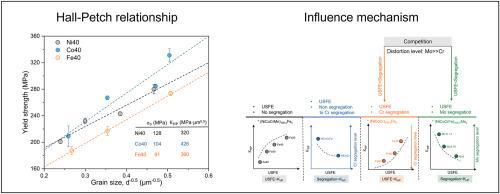Tailoring concentrations of principal elements to promote Hall-Petch strengthening of NiCoCrFe high entropy alloys
IF 4.8
2区 材料科学
Q2 CHEMISTRY, PHYSICAL
引用次数: 0
Abstract
Hall-Petch strengthening in high-entropy alloys (HEAs) involves complex interactions between grain boundary segregation and unstable stacking fault energy (USFE), yet their competitive roles remain unresolved. Here, we design three non-equiatomic NiCoCrFe HEAs (Ni40Co20Cr20Fe20, Ni20Co40Cr20Fe20 and Ni20Co20Cr20Fe40) to decouple these effects through controlled elemental variations. Systematic experiments reveal that: (i) Friction stress scales linearly with lattice distortion degree, confirming solid-solution strengthening dominated by atomic size misfit; (ii) Hall-Petch coefficients exhibit an anomalous sequence: Co40 (426 MPa μm0.5) > Fe40 (360 MPa μm0.5) > Ni40 (320 MPa μm0.5), defying predictions from singular grain boundary segregation or USFE theories; (iii) A unified competition mechanism framework is established, classifying systems into four types: non-segregation, segregation-transition, weak segregation, and strong segregation. Crucially, in weak-segregation systems, higher USFE overrides Cr segregation to maximize Hall-Petch coefficient. This work provides fundamental insights into the antagonistic grain boundary segregation-USFE interplay governing Hall-Petch behavior, enabling targeted optimization of strength-ductility trade-offs in HEAs.

调整主元素浓度促进NiCoCrFe高熵合金的Hall-Petch强化
高熵合金(HEAs)的Hall-Petch强化涉及晶界偏析和不稳定层错能(USFE)之间复杂的相互作用,但它们之间的竞争作用尚未得到解决。在这里,我们设计了三种非等原子NiCoCrFe HEAs (Ni40Co20Cr20Fe20, Ni20Co40Cr20Fe20和Ni20Co20Cr20Fe40),通过控制元素变化来解耦这些影响。系统实验表明:(1)摩擦应力随晶格畸变程度呈线性变化,证实了以原子尺寸失配为主的固溶强化;(ii) Hall-Petch系数表现出Co40 (426 MPa μm0.5) >、Fe40 (360 MPa μm0.5) >、Ni40 (320 MPa μm0.5)的异常序列,与单一晶界偏析理论或USFE理论的预测相违背;(三)建立统一的竞争机制框架,将制度划分为非隔离、隔离过渡、弱隔离和强隔离四种类型。关键是,在弱偏析体系中,较高的USFE覆盖了Cr偏析以最大化Hall-Petch系数。这项工作提供了对抗性晶界偏析- usfe相互作用控制Hall-Petch行为的基本见解,从而实现了HEAs中强度-塑性权衡的有针对性优化。
本文章由计算机程序翻译,如有差异,请以英文原文为准。
求助全文
约1分钟内获得全文
求助全文
来源期刊

Intermetallics
工程技术-材料科学:综合
CiteScore
7.80
自引率
9.10%
发文量
291
审稿时长
37 days
期刊介绍:
This journal is a platform for publishing innovative research and overviews for advancing our understanding of the structure, property, and functionality of complex metallic alloys, including intermetallics, metallic glasses, and high entropy alloys.
The journal reports the science and engineering of metallic materials in the following aspects:
Theories and experiments which address the relationship between property and structure in all length scales.
Physical modeling and numerical simulations which provide a comprehensive understanding of experimental observations.
Stimulated methodologies to characterize the structure and chemistry of materials that correlate the properties.
Technological applications resulting from the understanding of property-structure relationship in materials.
Novel and cutting-edge results warranting rapid communication.
The journal also publishes special issues on selected topics and overviews by invitation only.
 求助内容:
求助内容: 应助结果提醒方式:
应助结果提醒方式:


